Levana's panicle hydrangea - tips for care from experienced gardeners
Not so long ago, in specialized stores, they began to sell an elegant plant that emits a honey aroma, which quickly gained popularity among flower growers - it turned out to be Levana panicle hydrangea.
- Description of the variety
- Landing features
- Timing
- Seat selection
- Preparation of planting material
- Landing technology
- Care
- Watering
- Hilling and loosening
- Top dressing
- Pruning
- Preparing for winter
- Reproduction
- Cuttings
- By dividing the bush
- Growing from cuttings
- Diseases and pests
- Use in landscape design
- Testimonials
- Useful videos
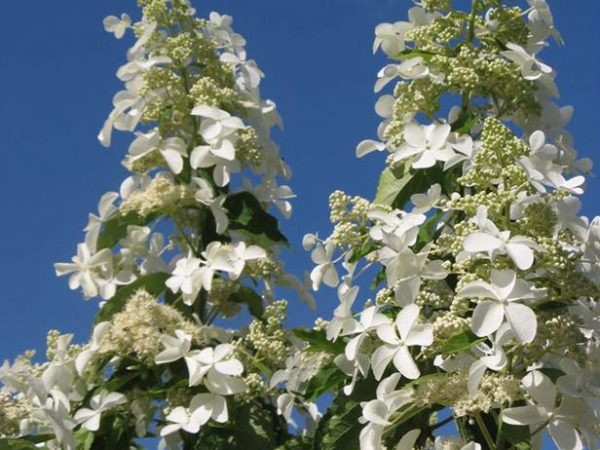
Hydrangea Levan description and photo
Description of the variety
The history of this variety goes back several millennia and originates in North America. In Europe, culture appeared in the second half of the 18th century through the efforts of the American naturalist and farmer John Bartram, who sent collections of new plants to Great Britain from various long journeys.
Hydrangea paniculata Levana is a fast growing crop capable of reaching a height of 2.5 - 3 m.
External parameters:
- shoots are strong, tough, growing vertically, have a light brown tint;
- the bush is lush, spreading, densely covered with foliage, does not fall apart after a snowfall, in rainy weather, therefore it does not need a garter or support;
- inflorescences are cone-shaped, large (30 - 50 cm, resemble a panicle (hence the name);
- the flowers are large, similar to a butterfly with spread wings, reach a diameter of 5 - 7 cm, snow-white, gradually acquire a pinkish-cream shade over time;
- the foliage is dark green, turns purple by autumn, the leaves are large, have pointed tips.
The flowering period lasts from June to October, before the first night frosts. The bush blooms profusely, while spreading a thick honey aroma that attracts insects, including bees.
Good resistance to low temperatures is observed. The plant is able to withstand frosts reaching -35 ° C, however, in especially cold winters there is a danger of freezing, so the bush must be covered for the winter.
Landing features
It is quite easy to raise Levana because of her unpretentiousness. The main thing is to follow the recommendations on the timing of planting, the choice and preparation of the site and planting material, the technology of the planting process.
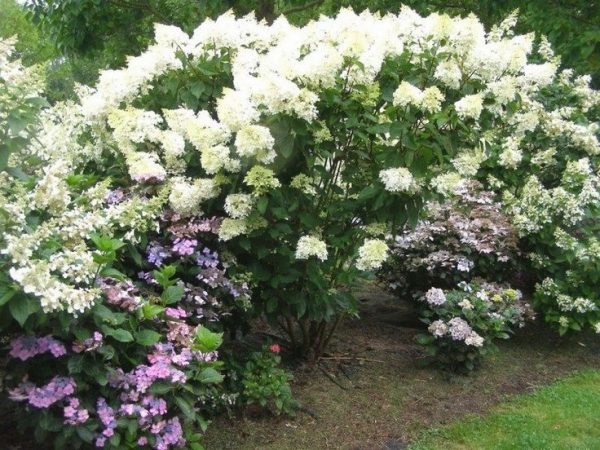
Hydrangea paniculata levana photo
Timing
It is advisable to plant hydrangeas at the very beginning of spring. This will give them the opportunity to get stronger, to take root in a new environment until the first frost. Plants are planted in an inactive sun, that is, early in the morning or in the evening.
Advice: before planting the seedlings, in order to avoid chapping of the roots and wilting, keep them in well-moistened soil or clay.
Seat selection
Hydrangea loves sufficient light and does not tolerate shade well, therefore it is recommended to plant it in well-lit areas, in beds located on the sunny side.
The plant should be illuminated for at least 6 hours a day. But it must be protected from direct sunlight. This is especially true in the hot midday hours.
The ideal growing area is in a damp lowland. In this case, it is desirable that the soil:
- was sour;
- contained a lot of humus;
- had good air permeability;
- had an insignificant lime content.
If the acidity level is insufficient, cover the soil with a layer of peat or needles. About a month before planting the plant, start watering the soil with water mixed with lemon juice or citric acid.
Important! Alkaline soil is undesirable.
Preparation of planting material
For planting hydrangeas in open ground, only seedlings are selected that have young shoots. If there are inflorescences, they must be cut off until next year.

Hydrangea Levan description
Preparation of planting material:
- water the seedlings well a few days before planting;
- do not cut the roots;
- do not remove the old earthy clod on the roots.
Add soil mixed with the soil mixture in which the seedling was grown to the dug holes for better adaptation of the plant.
Landing technology
Dig holes about 24 hours before your procedure. They must have a depth of at least 1 m and a diameter of about 0.5-0.7 m. The distance between the holes is at least 1 m 50 cm so that the overgrown bushes do not experience discomfort from crowding.
The planting process consists of the following step-by-step actions.
- Pour 2 buckets of water into the prepared planting holes. The soil must be thoroughly soaked.
- Fill the hole 1/3 full with fertilizer. It is prepared by taking 1 part of humus and soil, 2 parts of sand and peat and 20 g of urea.
- Place the seedling in the prepared planting hole. Spread out the roots.
- Fill the hole with soil. Do not deepen the root collar of the flower. Tamp the soil around the bushes.
- Water the planted seedlings liberally. Pour from 5 to 10 liters of water into each hole.
For better moisture retention in the soil, mulch the trunk circle. Hay, straw, dry high peat can act as mulch.
Do not under any circumstances apply a lime solution as a fertilizer! This will lead to the death of the culture.
Care
It is important not only to plant the hydrangea correctly, but also to properly care for it after that: water, huddle, loosen, fertilize. It is necessary to trim the plant, prepare it for winter.
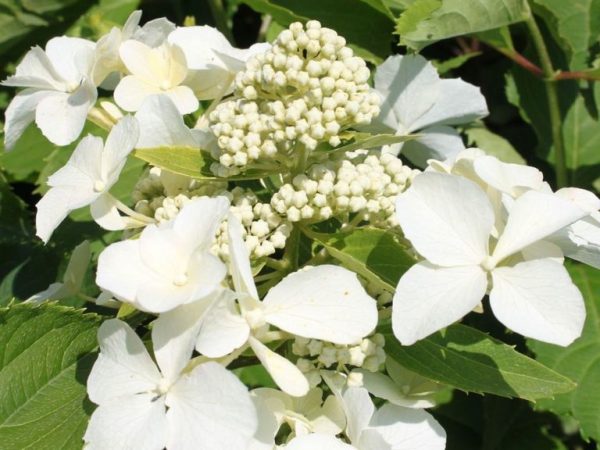
Hydrangea paniculata Levana description
Watering
The culture needs regular watering. This is especially important during the dry summer period.
Despite Levana's low indicators of drought resistance, watering should not be too abundant and frequent: it is enough to water the hydrangea weekly. 1 bush requires:
- from 5 to 10 liters of water;
- in particularly hot weather - up to 15 liters of water.
The specified moisture frequency and volume will prevent the soil from drying out.
Recommendation: use filtered or soft rainwater that has stood for 5 days.
Hilling and loosening
A planted hydrangea bush in the fall (best in October) is covered with earth and mulched with foliage, sawdust or peat. This is done for the first 2 years of plant growth.
Loosening is performed 2 to 3 times per season. Depth - from 5 to 6 cm. The procedure is carried out simultaneously with weeding the beds and watering.
Top dressing
In the case of competently prepared and fertilized soil in the garden bed during planting, there is no need to additionally fertilize the soil for the next couple of years.
After the specified time, feeding is carried out according to the following scheme:
- in the second half of May, apply fertilizer under the bushes, consisting of phosphorus, potassium, nitrogen;
- when the first buds appear, make a second feeding;
- periodically fertilize the plant with organic matter: chicken droppings, cow dung, etc.
When feeding with mineral complexes, do not overdo it with nitrogen: its excessive amount can cause problems with wintering, lead to greening of the petals.
Pruning
For more active flowering and giving the hydrangea bush splendor in the spring, before the beginning of the growing season, the plant is pruned.
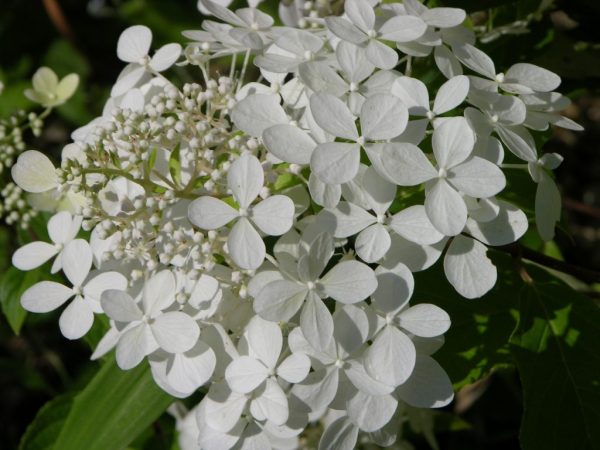
Hydrangea paniculata Levana photo and description
Remove:
- dried or faded inflorescences;
- stalks frozen in winter;
- weak shoots;
- old branches.
Young and strong twigs are shortened by 5 buds.
Tip: old bushes of hydrangea paniculata are best cut at the root. This will give an impetus to accelerate the growth of new, young shoots.
Preparing for winter
Panicle hydrangeas are one of the most winter-hardy members of the hydrangea family, but even they need at least minimal preparation for winter.
Prune your plants in the fall. After that, in young hydrangeas, it is necessary to cover the root system with mulch. Its layer should be at least 10-15 cm.
Mulching material can be:
- crumbling twigs and needles of coniferous trees (coniferous litter);
- dung humus;
- natural peat;
- foliage of deciduous trees.
Adult plants do not particularly need to cover the root system, but in order to avoid freezing in too severe frosts, it will not be superfluous to insure.
Attention! The mulch should not touch the shoots of the hydrangea - you only need to cover the soil.
In young Levan, twigs are tilted to the ground, sprinkled on top with sawdust mixed with soil or dry leaves, then covered with burlap, a piece of roofing material or a thick film.
The edges of the covering material are fixed with something heavy - bricks, boards, etc. In adult hydrangeas, it is difficult to tilt the branches to the ground, as a result of which they are simply wrapped with rope, and wrapped on top with a thick film.
For better transfer by plants of the winter period, in addition to pruning and shelter, it is advisable to feed the bushes with phosphorus-potassium fertilizer from a mixture of superphosphate and potassium sulfate in late August-early September.
If you do this later, hydrangeas will not have time to absorb the beneficial nutrients in full.
Reproduction
There are several breeding options for Levan's hydrangea: cuttings, dividing a bush, growing from cuttings. Each of them has its own characteristics.
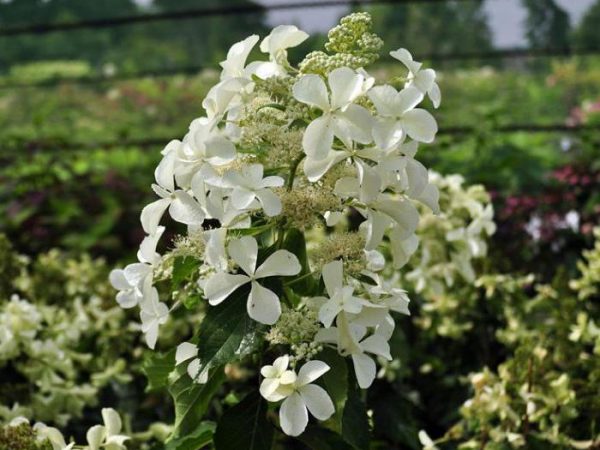
Hydrangea paniculata levana
Cuttings
To propagate Levana by cuttings, follow these steps:
- in spring, during pruning (from about April to June), look after annual shoots about 10 cm long;
- cut them off at an angle of 90 ° - so that 3 pairs of buds remain on the shoots;
- clean the bottom of the leaves;
- treat with a root growth agent;
- bury it 2/3 into a soil mixture consisting of 1 part sand and 2 parts peat;
- cover the cuttings with a thick film until rooting.
After the cuttings have taken root, the shelter can be removed. The cuttings must be sprayed daily, the soil must be moistened. For the winter, seedlings are harvested in a cool place. In the spring, those of them on which young shoots have appeared are planted in open ground. The emerging inflorescences are cut off until next year.
By dividing the bush
The method can be used if an adult Levana bush is already growing on the site. Dig it out, divide it into several parts.
The division should be carried out in such a way that each part has a bud for growth. Plant each part in open ground in a separate hole.
Growing from cuttings
Process:
- gently press young annual shoots in early spring to the ground;
- dig in so that a top with a height of at least 20 cm remains on the surface;
- water twice a week.
After the shoots take root, separate them from the parent culture and plant them in another place.
Diseases and pests
Chlorosis. Symptoms: lightening and loss of natural color leaves for no apparent reason. Reason: an excess of humus and lime in the soil. Treatment: spraying the bushes with a solution of nitric acid potassium and copper sulfate (copper sulfate). Prevention: control over the amount of applied humus, planting in soil with a low lime content.
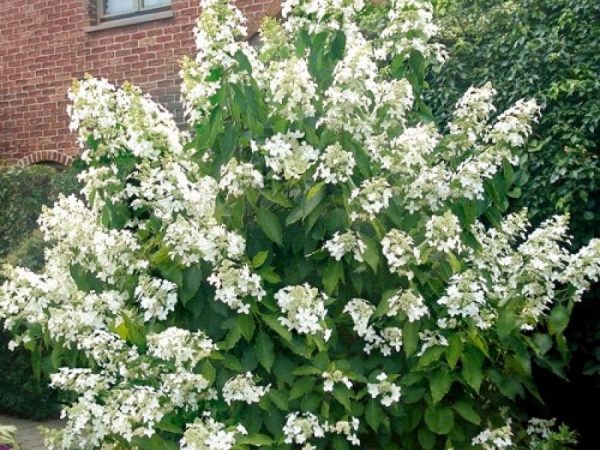
Hydrangea paniculata hydrangea paniculata levana
Peronosporosis (downy mildew). Reason: a fungus, the symptoms of which are a whitish coating on the inside of the leaves, gradual drying out and foliage falling apart. Treatment: treatment with a solution of laundry soap and copper sulfate, spraying with a 1% solution of Bordeaux liquid, biofungicides.Prevention: burning plant residues, digging the soil once a year to a depth of 30 cm, timely weeding.
Leaf aphid. Symptoms: curling, deformation and death of leaves, growth retardation, deformation of the top of the bush. Treatment: hilling with tobacco smoke, bathing in ash and soap or soap solution, weekly spraying with garlic and soap infusion (200 g of vegetable, 40 g of detergent for 1 bucket of water, leave for 2 days).
In general, the plant has an average resistance to diseases of a bacterial and fungal nature, a fairly good immunity.
Use in landscape design
Culture looks amazing as a hedge in city parks and playgrounds. It can be used to divide an area into segments. Will fit perfectly into the composition with conifers, woody perennials, undersized juniper, clematis.
Tip: when using Levana in compositions, try not to combine it with orange, red, yellow plants.
Testimonials
Hydrangea Levana appeared on store shelves not very long ago, but it has already become quite a popular culture among connoisseurs of decorative flowering varieties.
According to the reviews of many summer residents and gardeners, the plant attracts with its unpretentiousness, winter hardiness. It is enough to just take care of it, it is not difficult to reproduce. In addition, because of the snow-white flowers, the bushes always look elegant, create a feeling of celebration.

